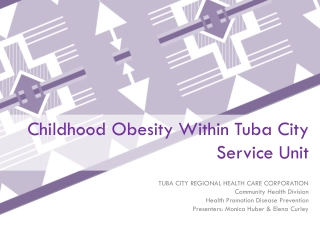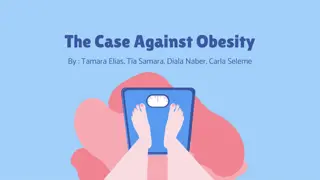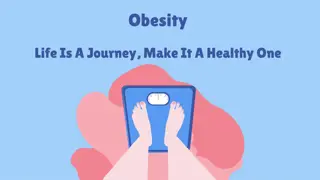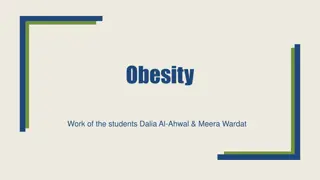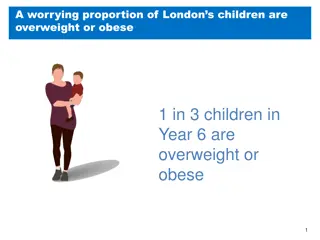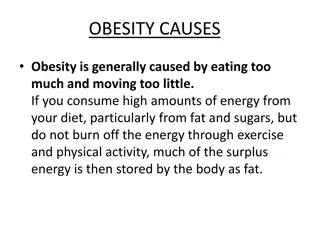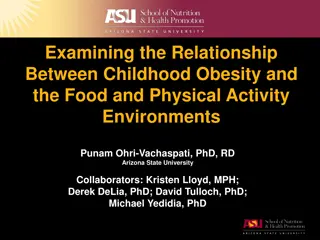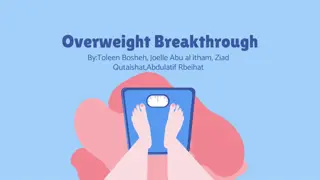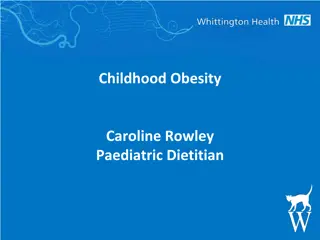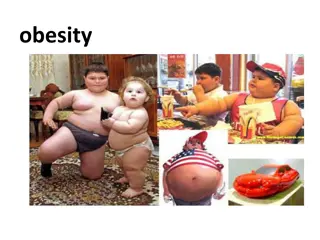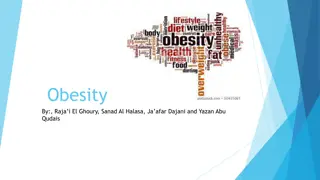Understanding Childhood Obesity: Physical and Emotional Impact
Explore the physical and emotional ramifications of childhood obesity, addressing key culprits like poor nutrition and lack of physical activity. Discover strategies to decrease childhood obesity, improve wellness, and enhance academics by integrating physical and nutrition education. Gain insights on innovative programs like bSAFE bFIT! to promote children's fitness. Emphasize the importance of actions over words in combating this critical issue.
Download Presentation

Please find below an Image/Link to download the presentation.
The content on the website is provided AS IS for your information and personal use only. It may not be sold, licensed, or shared on other websites without obtaining consent from the author. Download presentation by click this link. If you encounter any issues during the download, it is possible that the publisher has removed the file from their server.
E N D
Presentation Transcript
CHILDHOOD OBESITY Physical and Emotional Ramifications Written by: Renae Buss
Participant Outcomes: 1. Recognize two needs: a. Less talk, more action! b. One resource teaching both physical and nutrition education. 2. Become a leader to decrease childhood obesity, improve children s wellness, and optimize academics. 3. Re-examine the Local School Wellness Policy. 4. Receive information on an innovative fitness program for kids the bSAFE bFIT! Program for kids. 5. Walk away with ready-to-use learning strategies that excite children to be physically active while engaged in physical and nutrition education; linking schools, families, and the community.
KEY CULPRITS Poor nutrition Lack of physical activity
Physical Activity Healthy Eating
AVENUES School Family Community
The Child Nutrition and WIC Reauthorization Act Required for schools participating in the National School Lunch Program Section 204 addresses Physical Activity and Nutrition education
LESS TALK MORE ACTION Only words without action!
PHYSICAL EDUCATOR LEADERSHIP ROLE
TWO RESEARCHED-BASED RESOURCES COMBINED National Association for Sport and Physical Education (NASPE) United States Department of Agriculture MyPyramid for kids (USDA) ONE RESOURCE TEACHING BOTH PHYSICAL AND NUTRITION EDUCATION
Excite children to be physically active Engage in physical and nutrition education Link schools, families, and the community
EDUCATORS MEETING SCHOOL WELLNESS POLICIES!
Short and to the point Lessons completed in 5 to 10 minutes Beginning or end of day, during an activity break, after school programs, etc.
UNIQUE STRATEGY bSAFE bFIT! Program for kids
Physical Activity Jumping Jack Food Group Fruits WATERMELON JACK! (Fruits, Aerobic Fitness) Wow! Stand with your feet together and arms down at your sides. Jump, spread your feet apart, and lift your arms above your head. Return to how you started. Repeat in rhythmic motion!
bSAFE Five components of health-related physical fitness b S S trength A A erobic Fitness F F lexibility E E ndurance b ody Composition
Body Composition Squad Strength Squad Aerobic Fitness Squad Flexibility Squad Endurance Squad Grains Squad Vegetables Squad Fruits Squad Milk Squad Meat & Beans Squad
1. 2. Posters five 18 x 24 3. Activity Cards 55 4. CD 10 songs 5. Instructor DVD Manual with Lesson Plans
For yousample lesson 1. Lesson 5 2. Lesson 22
bSAFE bFIT! MANUAL MAIN CONCEPTS Body shapes and sizes PEDIATRICIAN IS THE BEST PERSON TO TALK TO ABOUT A HEALTHY BODY Calorie Needs and Expenditures Children 4-8 1200-1400 Girls 9-13 1600 Boys 9-13 1800 Children 2-3 1000 1000-1400 1400-1800 1600-2000 1800-2600 Physical Education National Association for Sports and Physical Education Warm up and Cool down Strength and Endurance Seven major muscle groups NASPE recommendations of 2 to 3 times a week using own body weight Aerobic Fitness How to take heart rate Children s resting heart rate (also appears on the poster) Flexibility NAPSE recommendations slow stretching Nutrition Education USDA MyPyramid Food Groups Grains, Vegetables, Fruit, Milk, Meat and Beans What foods are in each group(Fruits) Apples, oranges, grapes, etc. USDA recommended daily amounts Children 4 to 8 1 to 1 cups Girls 9-13 1 cups Boys 9-13 1 cups What counts as an amount 1 small apple equals 1 cup 1 cup grapes is equal to 1 cup
FITNESS PAL POSTERS Visual Learning
FITNESS PAL ACTIVITY CARDS 55 Fitness Pals (5 components, 5 food groups) For you: Sample Fitness Pal Suggestions for bSAFE bFIT! Activity Cards
MOVE N WITH FITNESS PALS CD 10 songs
bSAFE bFIT! Instructor DVD
GOPHER All educational tools range $139 to $179
OTHER REPUTABLE RESOURCES American Cancer Society (ACS) Center for Disease Control and Prevention (CDC) Caine Learning Institute
Food Tasting Comic Strips Diary of Vegetables and Fruits Nutrition Facts Food Label Portion Size versus Serving Size Spelling Relay Exercise at the Nursing Home For you Peppers Wellness Makes Sense Sardine Stroll with Students, Families, and the Community
Elementary WELLNESS Newsletter Le Mars Community Schools Physical and Nutrition Education Linking schools, families, and the community WELLNESS Childhood obesity has become a national concern. Overweight children are experiencing physical and emotional physical and emotional ramifications that are affecting their current and future health. Two key culprits have been identified as to reasons why childhood obesity is on the rise PHYSICAL EDUCATION Years ago, Physical Education was a sports promotion curriculum. However, major changes are erupting to transform the focus to self-improvement rather than being the best in a sport. My ultimate goal for your child s experience in Physical Education is that they develop the skills and attitudes to enjoy participating in lifelong physical activity. In order for your child to adopt a healthy and physically active NUTRITION EDUCATION A unique program I am using to implement nutrition education into my existing physical education curriculum is entitled the bSAFE bFIT! Program for kids. Portions of both the physical and nutrition education curriculums are We can make a positive difference in your child s life when we work together! Let s be safe and be fit!
MEANS TO AN END IMPLEMENTING NUTRITION INTO PHYSICAL EDCUATION CURRICULUM Improves children s: Fitness levels Knowledge Attitudes habits bSAFE bFIT! is a perfect fit! Decreasing Childhood Obesity Optimizing Academic


